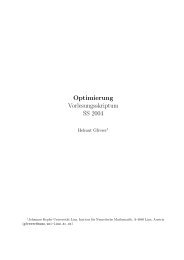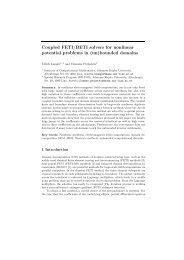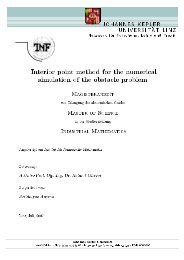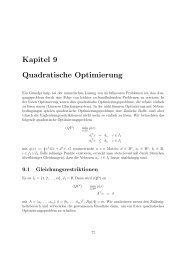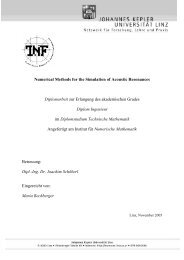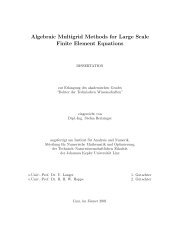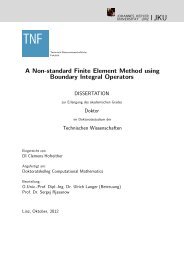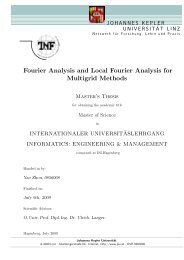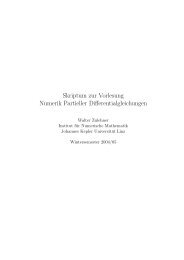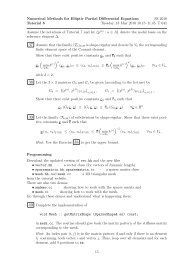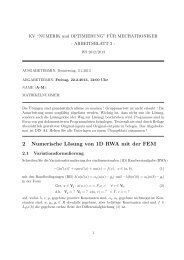Existence and Uniqueness of Eddy Current Problems in Bounded ...
Existence and Uniqueness of Eddy Current Problems in Bounded ...
Existence and Uniqueness of Eddy Current Problems in Bounded ...
You also want an ePaper? Increase the reach of your titles
YUMPU automatically turns print PDFs into web optimized ePapers that Google loves.
10 MICHAEL KOLMBAUER<br />
unique solution <strong>of</strong> the problem: For given u 1 f<strong>in</strong>d u 2 , such that<br />
⎧<br />
curl curl u 2 = 0, <strong>in</strong> Ω 2<br />
⎪⎨ div u 2 = 0, <strong>in</strong> Ω 2<br />
(9)<br />
u 2 × n = u 1 × n, on Γ I<br />
⎪⎩<br />
u 2 × n = 0, on ∂Ω 2<br />
Here we use the notation u i := u| Ωi for i = 1, 2.<br />
Lemma 9. The mapp<strong>in</strong>g H is bounded, i.e.<br />
‖H(u 1 )‖ H(curl,Ω2) ≤ c‖u 1 ‖ H(curl,Ω1), ∀u 1 ∈ H(curl, Ω 1 )<br />
Pro<strong>of</strong>. S<strong>in</strong>ce H(u 1 ) = u 2 is the unique solution <strong>of</strong> (9), it is classical to deduce that<br />
the follow<strong>in</strong>g estimate holds<br />
‖u 2 ‖ H(curl,Ω2) ≤ c‖u 1 × n‖<br />
H<br />
− 1 2<br />
‖ (div Γ,Γ I ) .<br />
Us<strong>in</strong>g the trace theorem the desired result follows:<br />
‖u 1 × n‖ − 1 ≤ c‖u 1‖<br />
H 2 (div ‖ Γ,Γ I ) H(curl,Ω1).<br />
The mapp<strong>in</strong>g H allows to def<strong>in</strong>e the space <strong>of</strong> curl curl-harmonic extended functions<br />
⎧<br />
⎫<br />
u ∈ H(curl, Ω) :u 1 ∈ H(curl, Ω 1 ),<br />
⎪⎨<br />
u 2 = H(u 1 ),<br />
⎪⎬<br />
Ṽ 0 :=<br />
.<br />
(u, w) L2(Ω) = 0, ∀w ∈ W(Ω 1 ),<br />
⎪⎩<br />
⎪⎭<br />
u × n = 0 on ∂Ω<br />
Us<strong>in</strong>g Ṽ 0 , we can state the variational problem as follows: F<strong>in</strong>d u ∈ L 2 ((0, T ), Ṽ 0 )<br />
with weak derivative ˙u ∈ L 2 ((0, T ), Ṽ0), ∗ such that<br />
[<br />
] ∫<br />
∫<br />
∂u<br />
σ 1<br />
∫Ω 1<br />
∂t v + ν 1(|curl u|)curl u · curl v dx+ curl u·curl v dx = f 1 ·v dx<br />
Ω 2 Ω 1<br />
for all v ∈ Ṽ 0 . Consequently by us<strong>in</strong>g u 2 = H(u 1 ) we can reduce the problem to<br />
one with support only <strong>in</strong> the conduct<strong>in</strong>g doma<strong>in</strong> Ω 1 . By recall<strong>in</strong>g the def<strong>in</strong>ition <strong>of</strong><br />
¯V (see (5)), we can state the variational form: F<strong>in</strong>d u 1 ∈ L 2 ((0, T ), ¯V) with weak<br />
derivative ˙u 1 ∈ L 2 ((0, T ), ¯V ∗ ), such that<br />
[<br />
∂u<br />
]<br />
1<br />
σ 1<br />
∫Ω<br />
(10)<br />
1<br />
∂t v 1 + ν 1 (|curl u 1 |)curl u 1 · curl v 1 dx<br />
∫<br />
∫<br />
+ curl H(u 1 ) · curl H(v 1 ) dx = f 1 · v 1 dx<br />
Ω 2 Ω 1<br />
for all v 1 ∈ ¯V.<br />
In order to apply Theorem 1 to the variational sett<strong>in</strong>g (10) the crucial po<strong>in</strong>ts are<br />
to show boundedness <strong>and</strong> coercivity <strong>of</strong> the bil<strong>in</strong>ear form. <strong>Bounded</strong>ness follows by<br />
the boundedness <strong>of</strong> the nonl<strong>in</strong>ear part <strong>and</strong> the boundedness <strong>of</strong> the pde-harmonic<br />
extension as stated <strong>in</strong> Lemma 9. In order to show coercivity, we proceed as <strong>in</strong> the<br />
unbounded case. S<strong>in</strong>ce we have the non-negativity property<br />
∫<br />
curl H(u 1 ) · curl H(u 1 ) dx = ‖ curl H(u 1 )‖ 2 L ≥ 0<br />
2(Ω 2)<br />
Ω 2<br />
we aga<strong>in</strong> obta<strong>in</strong> the estimate<br />
∫<br />
∫<br />
[ν 1 (|curl u 1 |)curl u 1 · curl u 1 ] dx+ curl H(u 1 )·curl H(u 1 ) dx ≥ c‖ curl u 1 ‖ 2 L . 2(Ω 1)<br />
Ω 1 Ω 2<br />
□



